My journey through INFO 287.
Click here to view.
My journey through INFO 287.
Click here to view.
One of the biggest complaints about the “new” public education system is that it is so focused on tests — the taking of tests, the preparation for tests, the results of the tests, the modifications to the curriculum based on the tests, and the funding dependent on the tests — that the experience of formal classroom learning has been whittled down the absolute necessities. Home Ec, shop classes, all the arts programs — they’re always in danger of losing their funding or already have to such an extent that they seem like a relic of a bygone era. The library is the perfect place to fill that gap, to continue all of those educational, necessary, and enjoyable experiences.

This crossed my feed after I posted this entry, but it fits
To facilitate this, as a society, we have to get away from the idea that “play” is a waste of money. Talking about makerspaces with a friend who works in tech, he said, “There’s a reason why the first coding experience is always with games.” You start with things that are small and inconsequential. In using a 3-D printer for the first time, you design a toy, not a prosthesis. That doesn’t make the toy a waste of supplies; it makes it the first step to a much longer path. I want to take a LinkedIn Learning class this summer to finally learn Adobe Photoshop, not so I can becomes some impressive graphics designer, but so I can tweak personal photos. This is real life. These are the experiences that people show up for. We support self-education through books; why would we not extend that to learning together especially when–in this constantly changing technological landscape–books about that topic might not exist.
And it doesn’t have to be practical. Let’s have dinosaur classes, bug classes, American Girl club – whatever people are checking out or want to learn about. Do you know how excited I would have been as a kid if my library had had a Santa Lucia Christmas party based on the Kirsten books? Teach me about the holiday. Let’s make festive Swedish foods. Let’s learn to cook new things that we may never have tried before and learn about cultures different from our own.
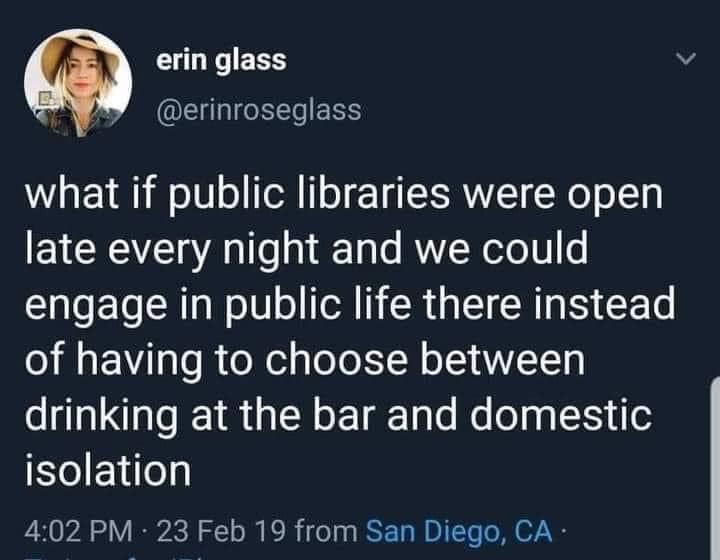
This has crossed my feed repeatedly recently, and almost without fail, the first comment is something about “Because we don’t wanna be shushed.” Maybe we just need to stop calling them libraries. Maybe the community center is just also where the free media to check out lives, like a really big free Redbox. If the library has “become the help desk for the community,” then maybe that’s how it needs to be branded for future generations (Kenney, 2015). Let the “shush” generation die out with us, so that the kids of today only know the “community center” as a place where learning is fun and everything interesting happens.
Relating back to Michael’s lecture about the NY virtual map, there’s a Facebook group that features tours of Gilded Age mansions and stories of the socialites, relating them back to the Julian Fellowes’s series on HBO. By all means, let’s curate all the stuff we can collect about the era–the books, the maps, the podcasts, the tv series, the movies–and create LibGuide-style pathfinders for our patrons (Stephens, 2017). “Obsessed with this? Here, take this. Also? Come on Monday night, and we’ll talk about yesterday’s episode while drinking tea and watching a recording of the actor who plays Mrs. Astor sing on Broadway. Can’t make it? Check out the group website, connected to the main library page and be ready for next week.” As Mathews (2013) stated, “Sometimes those spaces are virtual.” We talk a big game about using technology, but (at least my) library websites are places to access the catalogue or find out about services; rarely are they learning hubs themselves.
But they could be…
Other thoughts:
“We have the ability to connect people…” (Nygren, 2014). Building on the idea of the living books repository, what if we also had lists of community resources that the library could call on? Not just “I know a guy” when planning a new endeavor, but actively proposition our communities to let us know what they have to offer the world. Maybe we don’t need it now, but someday… For instance, if you wanna know about planning a European backpacking trip, I am your man. There’s no reason anyone in my town would know that, would not know to call on me if the need arose, but if they said, “What could you do a 10-minute talk on without preparation?” You betcha. Using those resources would strengthen community ties that are increasingly difficult to build. I can attest that it is absolutely possible in this day and age to live in direct proximity to people you’ve never met and have no reason to meet. That number goes up exponentially if you don’t have children or dogs.
I don’t work in a library, so my knowledge of the “why” is limited, but is there a reason why we would be wedded to the idea of keeping all library services under one roof, other than the ability to encourage cross-pollination? For instance, looking at the “Sensory Storytime” article, if there wasn’t space to include it in the branch, would it be so bad to lease a storefront on Main Street?
References
Administrator. (2020, February 17). Check out Marsden Library’s sensory space. Public Libraries Connect. https://plconnect.slq.qld.gov.au/blog/check-out-marsden-librarys-sensory-space
Kenney, B. (2015, September 11). Where reference fits in the modern library. Publisher’s Weekly. https://www.publishersweekly.com/pw/by-topic/industry-news/libraries/article/68019-for-future-reference.html
Mathews, B. (2013). Curating learning experiences: A future role for librarians? The Chronicle of Higher Education. https://www.chronicle.com/blognetwork/theubiquitouslibrarian/2013/09/05/curating-learning-experiences-a-future-role-for-librarians/
Nygren, A. (2014). The public library as a community hub for connected learning. IFLA 2014 Lyon. https://library.ifla.org/id/eprint/1014/1/167-nygren-en.pdf
Stephens, M. (2014, November 26). YLibrary?: Making the case for the library as space for infinite learning. State Library of Queensland YLibrary Project. https://www.dropbox.com/s/p46kkmbkvwpdsng/YLibraryInfiniteLearning.pdf?dl=0
Stephens, M. (2017, May 15). Office hours: Gifts of this hour. Library Journal. https://287.hyperlib.sjsu.edu/wp-content/uploads/2019/04/GiftsofthisHour.pdf
Community creation labs in public libraries are commonplace worldwide, yet none of the libraries in Placer County have adopted the trend. This report discusses makerspaces, their history, the process of adoption, and the challenges inherent in doing so. By coordinating with community and staff from the start, the library can ensure engagement across all age levels & bring new patrons into the space. Adapting in this way prepares patrons for the skills they will need in the future.
Click here to view.
I am fascinated by the Living Book projects, but I wonder if it would be possible to take it one step further – if the people who had good experiences with the program would be willing to become a repository, not just of their ten-minute presentation, but as a library resource?
Here is what I am picturing:
In the library, there is a human book entitled Twice-Exceptional Autistic Adult. [This refers to adults with autism who also have high IQs that have usually allowed them to successfully mask their disabilities and avoid detection, sometimes for decades.]
Scenario: A 51-year-old man hits career burnout. He is hospitalized for clinical depression, but in the course of his treatment, he is tested for autism and it comes back very positive. Suddenly, he is plunged into a whole new world of data, therapy, and coping strategies. However, the research into 2E Adult Autism is minimal, mostly because those diagnoses are just now happening as Gen-X hits middle age. Would it not be amazing to have a “human book” that one could check out to talk to about this incredibly specific life journey? Or as a parent, to talk to a person who is a version of the adult your child will become, to find out what you can do now to help smooth their path?
Another example:
Scenario: Your child / friend thinks that they may be asexual. The research on asexual humans is minimal; even fictional representation is nominal. Would it not be great to have a “book” to check out to ask very specific questions about their experience and what kind of support they would have appreciated in their life?
I know this is just basically a conversation, but these very niche topics do not have support groups, and if one already has the books on file for the event, then it is a unique starting place.
A couple other thoughts on this week’s readings:
I am fascinated by the world of hygge in its coziest form: the fuzzy socks and blankets, the sweaters and candles, the faux fur and the fleece. I know it stems from being perpetually cold and daily battling drafts, cold drinks, and any temperature below 90-degrees.
When I look at the libraries of the future, with their concrete and massive windows (think Dokk 1), I shiver. I can already picture the tendrils of cold air caressing the back of my neck while I huddle in my coat. Today’s revelation that some libraries are beginning to install fireplaces was delightful.
Which begs the question: What else can we do to warm up the library?
Much thought goes into the creation of children’s sections and teen areas, with their bright colors, murals, and jungle gyms. What stops libraries from creating one additional themed space for adults: the library-within-the-library?
Library bars, restaurants, and hotels exist all over the world, with their old-world decor, muted lighting, and comfortable chairs. The NoMad Hotel group has opened three Library Bar/Restaurant locations in New York, Las Vegas, and London. The books contained therein are specific to each region’s tourism, history, and architecture.

NoMad Library Restaurant, Las Vegas
The Citizen Hotel in Sacramento won’t appear on anyone’s “Best Library Bars in the World” list, but each floor boasts comfortable chairs and walls lined with bookshelves. Whether the books have been recovered to match or whether they are dummies remains to be seen.
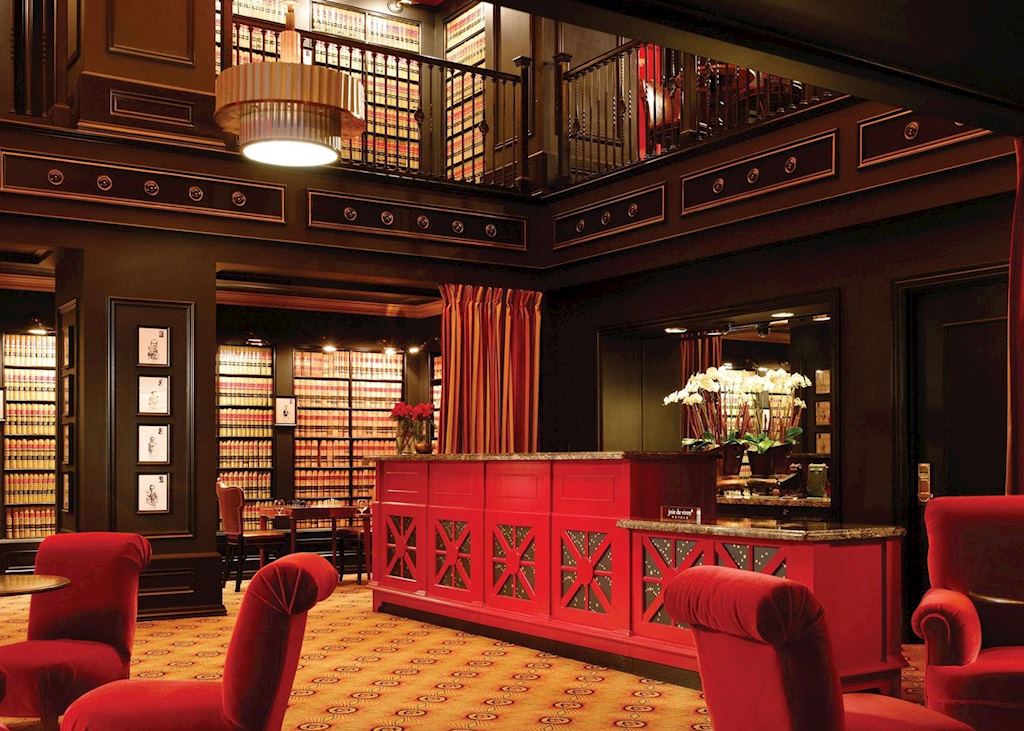
Citizen Hotel, Sacramento
The Metropole in Monte Carlo‘s lobby bar combines shelves of borrowable tomes with the mystery of a hidden doorway — which leads to the bathroom, not to another library, unfortunately (Bartz, 2017).

The Metropole, Monte Carlo
Speaking of hidden doorways, the San Francisco speakeasy Bourbon & Branch, accessible only with a password given at an unmarked door, has two spaces, the full bar and the standing-room only Library. While the lighting in that bar has never been good enough to actually read by, it’s the thought that counts.
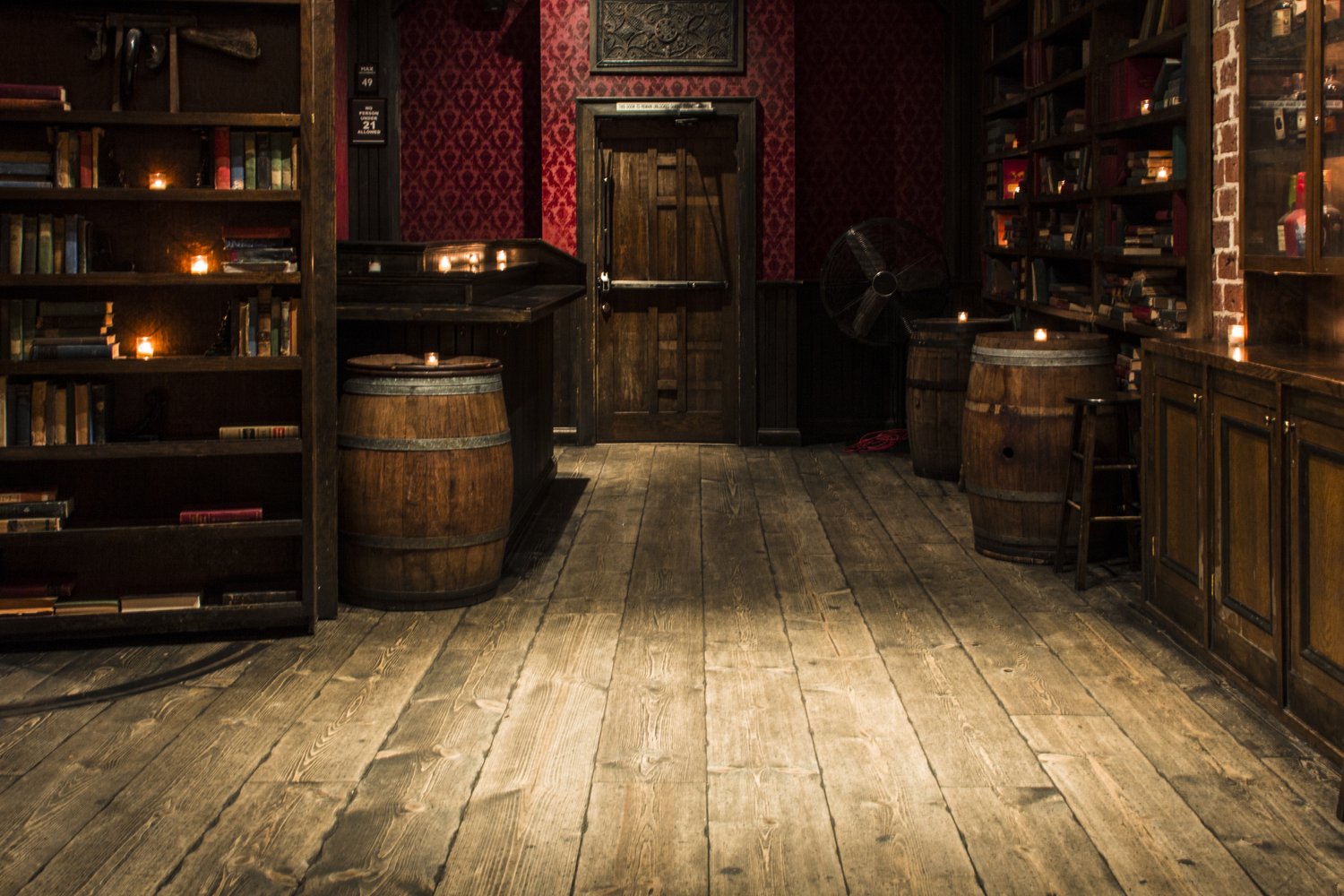
Bourbon & Branch, San Francisco
The woman-owned Library Bar in Los Angeles offers a refreshing alternative to thumping bass perfect for first dates and real conversations. Their signature cocktails are all literary-themed. (Yes, there is a Tequila Mockingbird.)
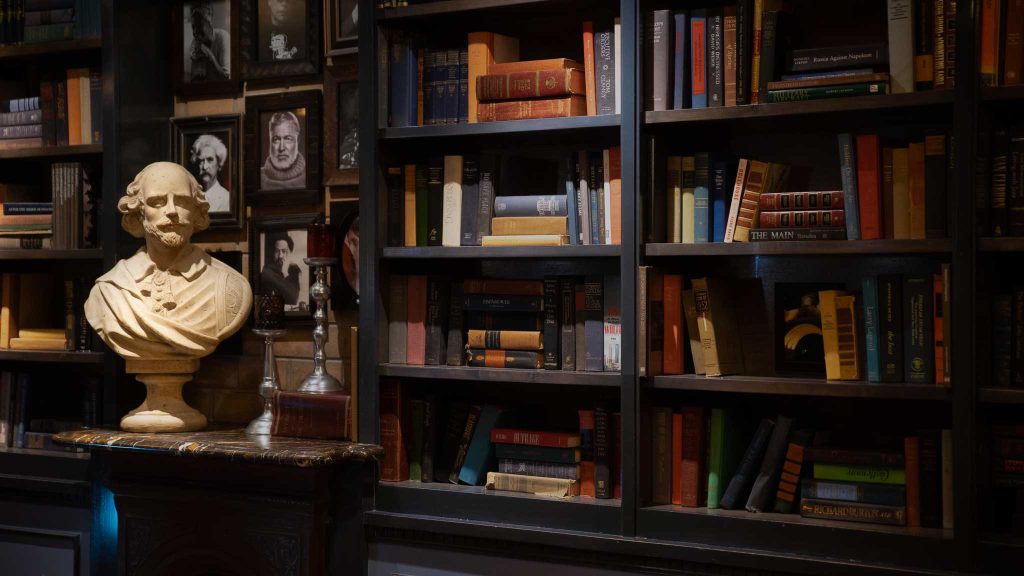
Library Bar, Los Angeles
Imagine the library space with the gas fireplace(s), faux leather club chairs, interesting tchotchkies from world travels, and long wooden tables with banker’s lamps (ala the NYPL reading rooms). Should libraries finally ditch the Dewey System and switch to the Merchandise Model, then this would be an excellent place to store the classics and the history section. Should it be accessible only by a “hidden” doorway from the main library and contain a rolling ladder, it would be perfection.
Just something to consider.

The Reading Room, NY Public Library
Placer County Library, Rocklin branch, shall introduce a new “technology playground” as well as accompanying fortnightly “Connecting with Technology” workshops and an expansion of the website to include a space for YouTube tutorial videos created during this endeavor. The project would seek to include the community through a number of avenues: surveys to brainstorm what technologies to include, teaching sessions, evaluating the continuation of the program and individual technologies, recording and posting video segments, and the eventual consumption of said videos. The new endeavor would allow the library to continue its mission to educate the public in all avenues of cultural life and fill a vital gap in the current landscape, namely introducing prohibitively expensive new technologies to the populace.
I feel like The New York Times summed up the entire history that led to this class in one sentence: “Curators 35 years ago were not interested in what the public needed — they were interested in what the curators thought the public should have.” For those of us who grew up in that environment, I’m not sure that asking will help – we the public do not necessarily know what we want until it is handed to us, at which point it becomes unacceptable to not have that thing, much like a smart phone or wi-fi.
There is an ever-widening digital divide occurring between GLAM organizations that have embraced technology and those that have not, but if one were to ask me – an educated but not particularly interested in art person – what I would want from my local museum in order to bring me in the door, I do not know what I would tell them: “Um… get more interesting stuff? Maybe famous stuff I have heard of before?”
Which begs the question: Why have I heard of some art but not others?
Which opens the floodgates.
During my BA, I did an involuntary cognate in Art History that was required by my major. In those courses, I was told the stories of art. I learned the soap opera that was the life of the artist. I learned about the incredibly specific techniques used to create the art, and how each artist built on the work of their predecessors to create something new and exciting. I learned about the controversies that surrounded the exhibition of these pieces. In those lectures, the pieces – that would otherwise have been “yep – that’s a tree/statue/soup can” became set pieces on the epic stage that is history.
The works of Dan Brown are greatly maligned by the literary community, but viewing art and architecture in Rome or Paris or London after reading those books hits differently than before. The context changes the perception.
A friend has a different perspective. He is not a story person. He plays expansive MMORPGs and has absolutely no idea what is happening between NPCs. (It is maddening.) For him, he could not care less about the artist or the patron. When he goes to an art gallery, he “looks at the pretty pictures.” What does strike him, though, is the process of making photo-realism from paint or marble. He would love to see the process in layers, rather like the time-lapse videos on social media. [Watch this on double speed with the sound off to get an idea of what I mean.]
There are incalculable variations on this theme, but it boils down to these two points: Context gives meaning to the meaningless, and there is no one-size-fits-all answer to “What do people want?” There is only “more.”
Remember the interactive science museums of our childhoods with the handles to crank and the circuits to connect? What if we used the new technology to make all museums as interactive? Gamify the GLAM experience. Use the art as the basis for scavenger hunts, with quizzes and badges to earn along the way. Market them to everyone, not just children. Adults like games too. Ensure repeat visitors and creative use of the space by making badges collectable over years. Use the experience of the old docent-led tours to point viewers along the path of the museum, stopping at specific pieces that tell one cohesive story, rather than leaving it up to the patron to choose random pieces about which to learn. (Ensure that by the time one collects all the badges, they will have seen everything.)
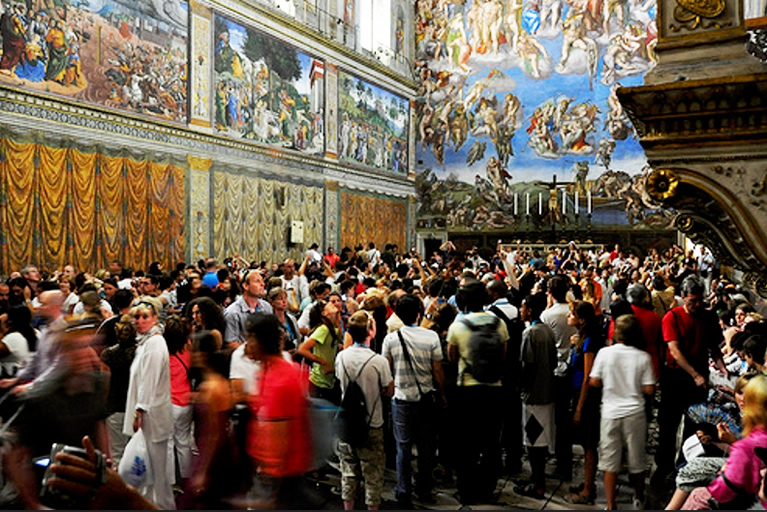
Visitors inside the Sistine Chapel
Use the VR experience in places where one cannot actually see the art. The Sistine Chapel in the Vatican City is one of the most visited pieces of art in the world, but it is also 68 feet in the air. Imagine a VR experience where one could examine individual portions at leisure while also hearing the story of Michaelangelo’s endeavor and his relationship with Pope Julius II or seeing a ramped dramatization of the process.

CROSSING THE ISTHMUS, CIRCA 1858.
Albertus Del Orient Browere (American, 1814–1887)
Oil on canvas, 33 x 44 in. Crocker Art Museum Purchase, 1984.8.
The Crocker Art Museum in Sacramento “was the first public art museum founded west of the Mississippi, established in 1885.” According to its website, it houses “the state’s premier collection of Californian art, dating from the Gold Rush to the present day,” but without additional context, that painting by Albertus Del Orient Browere is just a hill in Panama. I have no idea why it is in a museum as opposed to someone else’s of a still life of fruit. Place it next to a piece that would never be put in a museum on the app; show me the difference between “art” and “trash.”
According to the Our Museum report, one of the biggest concerns is fear: “But what if we implement all of these changes and they don’t work?” or worse: “What if we waste all the money on a losing proposition?”
When dealing with limited finances, the fear of failure — of wasting precious resources — is a huge barrier to creation. As much as it seems counterproductive, we have to build in an expectation of failure. In science, failure is the norm. Even when something is a success, it must be replicated over and over before it is trusted. We have to set aside the necessity of immediate gratification and consider each minute participatory activity as a building block not of a program but as a piece of the much larger puzzle that eventually says, “The GLAM organization is the place where the things happen.” Maybe you try the Smartify app, but you realize that it only really works outside because the building has terrible cell service or there are too many people using the wi-fi (think the Louvre at capacity). Maybe the Beacons that use Bluetooth inside are too affected by the crowds around certain objects. That is okay – there is bound to be a return policy, or another organization who could use them. The app that failed at the Crocker could be repurposed for the Wide-Open Walls project that creates murals throughout downtown.
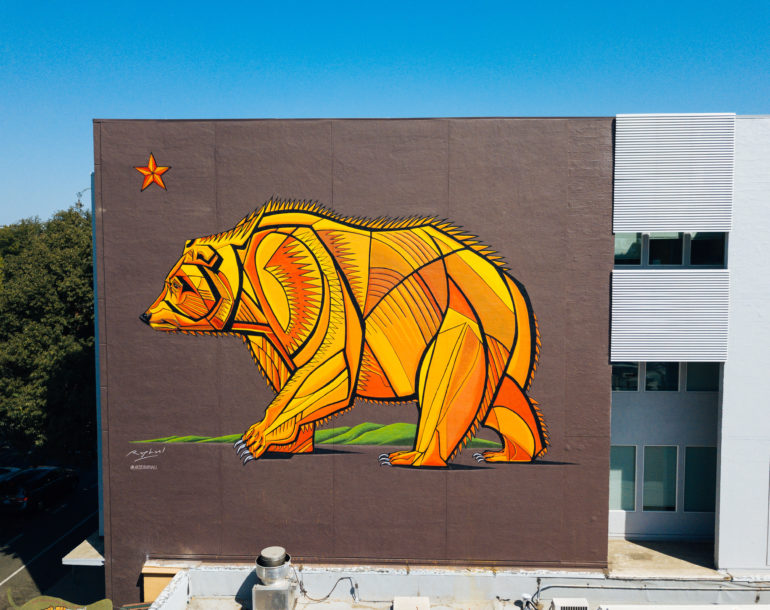
Raphael Delgado: California Bear (2017)
If you tried to put together a puzzle but you were afraid to place the first piece because it might not be exactly right, how far would you get? “We acknowledge that any large-scale organisational change takes at least five years – and at least that long before we know if it really is succeeding.” Unless there is a sudden social-media viral response to something (we can only dream), it will take ages before people change their opinions, before all the people who attended and were disappointed can be convinced to come back and try again. The important part is that the organization is seen to be doing something. Even if it wasn’t wholly successful the first time, patrons will check back to see what is happening now. “Maybe this time, it will be something I like.”
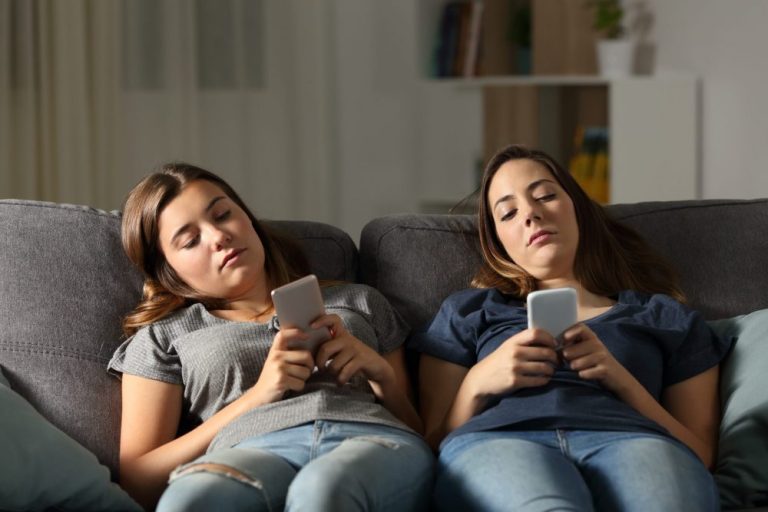
My last post discussed the inaccessibility of local library resources for working adults (and their children). Building on that theme, let us discuss the lack of activities for adults.
I have lost track of the number of times that programming for kids and teens have come up in this program. For humans with a lifespan of nearly 80 years, the library – it would seem – is only interested for the first 17. Kids and teens who are already in a space entirely dedicated to their education for 8 hours a day, who have enrichment and extra-curricular activity options pouring out of their ears, who already have school libraries (and eventually University libraries), also have the public library.
These are the activities in the library in my town this month (and every month – the calendar does not change):
I am not arguing with the benefits of all of these programs. However, what does that say to everyone else?
“The library is not for you.”
Think of all the content that has been billed as “teen” activities. Slap that label on everything interesting, and what does that tell the adults:
“Go away. This is not for you either.”
Do we think adults are too busy to attend programming?
Too rich to need free activities?
Too tired after work to leave the house?
The people attending pub quiz nights, paint nights, movie theatres, and karaoke bars would beg to differ.
Things I Want to Do at The Library:
The point is that adults are busy, yes, but they still like to hang out with their friends or attempt to make new ones. Sitting in a bar screaming over the music is only fun if you don’t have anything to say.
Imagine, instead, a full slate of community-led, community-run programming where there is literally something going on all evening every evening. Got a free evening? Show up and join the fun.
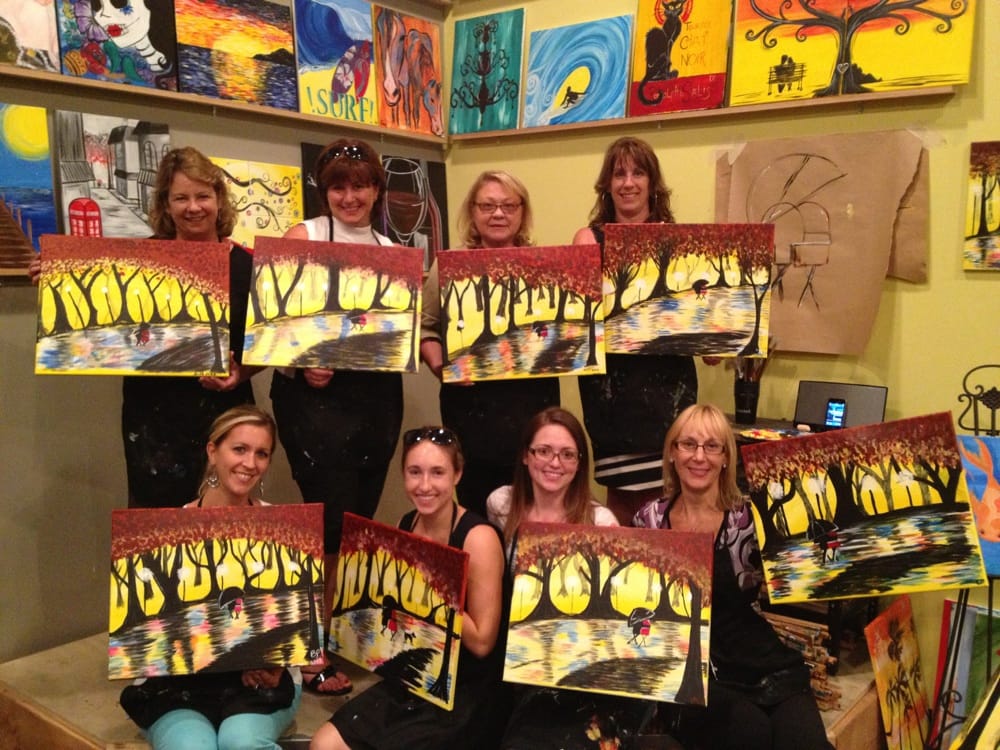
Women show off their Paint Night creations
As Pewhairangi states, “The principal currency today is no longer information, products, or services; it is human attention.” If we want to combat the epidemic of lonliness, then it would behoove us to find the socially isolated people — people who live alone, work from home, whose only connections are colleagues on a Zoom/Teams call. If one in eight people are experiencing such high psychological distress that they’re at risk of premature death (Greenwood), then how can we help them find a community of their own? Why don’t we ask them what they would like to do, not just at the library but anywhere? We might be surprised at the kinds of things that people do not do because they cannot afford it — or afford the constant supply of food and beverages required to stay at a table there — but would like to get out from behind their screens and interact with the world (Schmidt).
Maybe it’s time that everything at the library isn’t just for kids, nor just for readers (Stephens). If we wish to keep those children coming back to the library after they graduate from high school, then we need to have something for them to do when they get there.

Placer County Library, Rocklin branch
As a young teacher, absolutely unable to afford anything but Bay Area rents, the library was my bookstore. I had my card number memorized from the repetitive action of inputting it into the holds system.
In that, I was privileged. My work day ended at 3:30 P.M. I had time before the library closed to visit and leisurely peruse the stacks in the same way I had lingered over them as a child.
Library literature has much to say about keeping up with the times, but the biggest issue facing libraries in California is old-fashioned: They are not open when people need to use them.
Of the seven Placer County libraries, none is open before 10 A.M. or after 6 P.M. None are open on Sunday or Monday (Placer County Library, 2024b). We do not have a city library, but the next town over has three. Of those, one branch is open until 7 one night a week. The others are, at best, 9 to 6, and all are closed on Sunday (City of Roseville, 2024.)
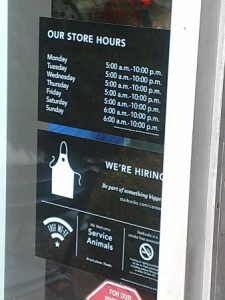
Starbucks is open when people can visit. Be like Starbucks.
Google maps says that the standard weekday commute for the 22 miles from the Sacramento Capitol building to the county library is anywhere from 30 to 60 minutes on a good day (Google Maps, 2024). If those who work bank hours want to visit the library, they need to add it to their Saturday chores. No wonder they choose Amazon. When Starbucks is closed? When the gym is closed? (Hint: Just long enough to clean and start again.) If, as Panos Mourdoukoutas (2018) suggested, “third places” like Starbucks have replaced libraries, it is because in most urban or suburban areas, there is bound to be a Starbucks open from 5:00 A.M. until 9:00 P.M., probably within walking distance.
When Mourdoukoutas posited that “Amazon should replace local libraries to save taxpayers’ money,” and the world collectively hissed in response, the argument was that the poor and working classes utilize library books, computers, and story times, but either we only mean the unemployed, or we only mean people working second and third shifts. According to the United States Bureau of Labor Statistics (2019), that accounts for 16% of the population. Even the county Adult Book Clubs and ESL Clubs meet in the middle of the weekday, indicating that they focus their attention on the same populations (Placer County Library, 2024a). Work from home has certainly helped, but the vast majority of the country has incredibly limited access, either because they are working or because their working parent has to drive them there.
If we want libraries to be central to people’s lives, to increase patronage, and to be the new community center, then we need to be available when the people are able to attend. I am not quite advocating for Devarai and Devarai’s (1997) Round-the-Clock Librarianship — though, I would imagine that an on-site librarian job that provided housing would have thousands of applicants — I just want to give the American workers who are busy during first shift their shot at a free education. If the funds will not stretch to a 24/7 open space — without the arbitrary closing times described by Wallin (Zulkey, 2019), then perhaps it is time for all libraries to adopt bibliotheca’s Open+ system for the daytime library hours (aka the book people) so that the library can be open all evening for the community part of the equation (Bibliotheca, 2024). Maybe one location is open all day and another all afternoon. Perhaps the evening activities need to be run, not by librarians, but by the Parks and Recreation division; in that vision, the library simply becomes the place where it happens, not the focus of the activity.

Don’t leave out the working adults when planning library programming.
The library needs to reinstate itself as a recreational space for all demographics, the one place where people can go and not be expected to spend money, not have to “move along” within a nebulous time frame (TomatoFruitBat, 2023). We should strive for people to see the library not as a book repository, but the place where their community – whatever that may be — gathers (Mattern, 2014). Think what could be accomplished with all those extra hours – entire days of community programming designed to attract everyone, not just the limited few. In order to accomplish that, the assumption has to be that it will be open and available when people are making plans to be there. We need to stop being afraid of what people might do to our precious spaces (A_Monster_Named_John, 2022) and instead be excited about what they might accomplish (Holmquist, 2016).
References
Bibliotheca. (2024). Extended access: Increase open hours and improve service. https://www.bibliotheca.com/solutions/extended-access/
City of Roseville. (2024). Locations & Hours. Roseville Public Library. Retrieved 14 February 2024, from https://www.roseville.ca.us/government/departments/library/about_us/locations_n_hours
Devarai, R. & Devarai, K. (1997). Extended library hours. Indian Journal of Information, Library and Society, 10, 3-4. https://www.researchgate.net/publication/28802973_Extended_Library_Hours?_tp=eyJjb250ZXh0Ijp7ImZpcnN0UGFnZSI6InB1YmxpY2F0aW9uIiwicGFnZSI6InB1YmxpY2F0aW9uIn19#read
Google Maps. (2024). Directions. https://maps.app.goo.gl/pdFysdpnaEPmRxWa9
Holmquist, J. (2016, April 6). Open libraries: Self-service libraries – the Danish way. https://janholmquist.net/2016/04/06/open-libraries-self-service-libraries-the-danish-way/
Mattern, S. (2014, June). Library as infrastructure. Places Journal. https://placesjournal.org/article/library-as-infrastructure/
A_Monster_Named_John. (2022). If this is actually the reasoning, then it’s a good thing for an initiative like this to fail. Left in [Online forum post]. Reddit. Retrieved 9 February 2024, from https://www.reddit.com/r/Libraries/comments/s5fst7/comment/hsynqgz/
Mourdoukoutas, Panos. (2018, July 21). Amazon should replace local libraries to save taxpayers money. Forbes. https://www.forbes.com/sites/panosmourdoukoutas/2018/07/21/amazon-should-replacelocal-libraries-to-save-taxpayers-money/#22dd623660a8
Placer County Library (2024a). Adult Book Club. County of Placer. Retrieved 5 February 2024, from https://www.placer.ca.gov/9136/Adult-Book-Club
Placer County Library (2024b). Location and Hours. County of Placer. Retrieved 5 February 2024, from https://www.placer.ca.gov/9078/Locations-Hours
TomatoFruitBat. (2023). We shrug this off like it’s a “that’s life” or “well, inflation sucks, nothing’s free” kind of thing. But it [Online forum post]. Reddit. Retrieved 5 February 2024, from https://www.reddit.com/r/Sacramento/comments/10l56n6/comment/j5vrq9o/
U.S. Bureau of Labor Statistics. (2019). Job flexibilities and work schedules summary. https://www.bls.gov/news.release/flex2.nr0.htm
Zulkey, C. (2019, September 3). Automatic for the people. American Libraries. https://americanlibrariesmagazine.org/2019/09/03/automatic-people-self-service-libraries/
I’m in my second semester of the MLIS program and, since I’m not past the 19-credit threshhold to switch to Special Session, I’m therefore limited in my class selections to those available to Regular Session students. I really enjoyed Dr. Stephens’s style in INFO 200, so I decided to take his INFO 287 course as well. I don’t yet have an area of emphasis for the program. I joined assuming that I would obviously become a public librarian, but the more that I explore, the more appealing archives and museums become. We’ll see.
This semester, I’m looking forward to implementing on Day 1 all the systems that grew out of necessity last semester. My class load is greater, but I think I know what to do this time to stay on top of it. Fingers crossed.
I’m not a social media person. I don’t have a Facebook or Instagram or whatever the kids are using these days. My accounts are purely to access the unending stream of videos I receive via private message. Thus, I won’t be posting my photos or such. I will, however, give you this link to one of my favorite poems: Breathe.
Update (21 April 2024):
This did not age well. As you can see, my picture is up. I still don’t post to socials, but then again neither do most people my age anymore. We burned out during the first wave.